Taekwondo Classes in Salisbury
Tae Kwon Do
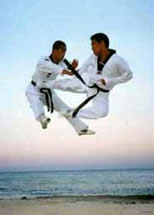 Tae Kwon Do is the world’s most popular martial arts with 170 participating nations.
Tae Kwon Do is the world’s most popular martial arts with 170 participating nations.
Taekwondo is one of the most systematic and scientific Korean traditional martial arts, that teaches more than physical fighting skills. It is a discipline that shows ways of enhancing our spirit and life through training our body and mind. Today, it has become a global sport that has gained an international reputation, and stands among the official games in the Olympics.
Sign Up For Your FREE Introductory Lesson
Tae Kwon Do is the world’s most popular martial arts with currently 188 participating nations.
Taekwondo is one of the most systematic and scientific Korean traditional martial arts, that teaches more than physical fighting skills.
It is a discipline that shows ways of enhancing our spirit and life through training our body and mind.
Today, it has become a global sport that has gained an international reputation, and stands among the official games in the Olympics.
“Tae” “Kwon” “Do” is composed of three parts as shown in the English spelling, though it is one word in Korean. “Tae” means “foot,” “leg,” or “to step on”; “Kwon” means “fist,” or “fight”; and “Do” means the “way” or “discipline.” If we put these three parts together, we can see two important concepts behind “Tae Kwon Do”.
First, Taekwondo is the right way of using Tae and Kwon ‘fists and feet,’ or all the parts of the body that are represented by fists and feet. Second, it is a way to control or calm down fights and keep the peace. This concept comes from the meaning of Tae Kwon ‘to put fists under control’ [or ‘to step on fists’]. Thus Taekwondo means “the right way of using all parts of the body to stop fights and help to build a better and more peaceful world.”
Taekwondo has been developing with the 5000-year long history of Korea, being called by several different names in the course. In Korea, Taekwondo began as a defense martial art called “Subak” or “Taekkyon,” and developed as a way of training body and mind in the ancient kingdom of Koguryo, under the name of “Sunbae.” In the Shilla period, it had become the backbone of Hwarangdo that aimed at producing leaders of the country.
Taekwondo today is similar to the martial arts in other Oriental countries and shares some features with them, because in the course of its evolution it has gained many different styles that existed in the martial arts of the countries surrounding Korea, like Japan and China.
But Taekwondo is very different from many such oriental martial arts. First, physically it is very dynamic with active movements that include a multitude of foot skills. Second, the principle physical movements are in simpatico with that of the mind and life as a whole. Third, it possesses dynamic poses from another perspective.
Taekwondo can be characterized by unity: the unity of body, mind, and life, and the unity of the pose [“poomsae”] and confrontation, and cracking down. When you do Taekwondo, you should make your mind peaceful and synchronize your mind with your movements, and extend this harmony to your life and society. This is how in Taekwondo the principle of physical movements, the principle of mind training, and the principle of life become one and the same. On the other hand, the right poomsae lead to the right confrontation, which will eventually produce great destructive power.
How do we reach such a unity in Taekwondo? Taekwondo is a way of life, much like having a job, raising a family, fighting for a cause, or any one of numerous raison d’etre. What makes Taekwondo different from these is that it is an activity for survival in extremely antagonistic situations. One must always overcome the enemy that is trying to cause harm. But simply winning a fight is not enough to guarantee one’s safety, because the enemy may recuperate and attack again. Moreover, there may be many other enemies than the one that was just defeated. One cannot ever feel safe unless one gains permanent peace. To attain this permanent or lasting peace, one needs unity. This is what Taekwondo aim for. Otherwise Taekwondo would be no different from any other street-fighting skills.
Taekwondo pursues harmonious growth and improvements of life through its unique activities. This is why one could say Taekwondo is a way of life. To ultimately enable ourselves to lead more valuable lives, we would do well by finding the guiding principles deeply hidden in Taekwondo.
Click here for more information
There are several key aspects of Taekwondo which we will address. These are:
• Traditional Taekwondo (Park’s Martial Arts lineage)
• World Taekwondo Federation (WTF)
• United States Taekwondo Union (USTU)
• Delaware State Taekwondo Association (DTA) Our Grand Master Park was the founding President
• Olympic (Sport) Taekwondo
• Sport vs. Traditional Taekwondo
• Other styles of “Taekwondo”
Traditional Taekwondo
Park’s Martial Arts Tae Kwon Do lineage derives from the Chang-Moo-Kwan est.1946. The “Chang-Moo-Kwan” (Development of Martial Arts Training Hall) was founded by Yoon, Byung In at a YMCA.
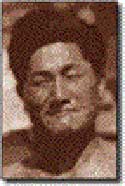
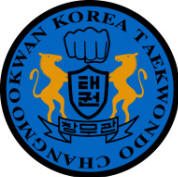
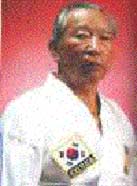
Yoon spent his childhood in Manchuria and learned “Joo An Pa”, a Chinese martial art (more commonly known as, Chuan Fa). In the 1940’s, he went to Japan to study abroad. While there, Yoon claims he studied Karate under the direction of Kanken Toyama, founder of Shudokan Karate, earned a 5th Dan, and was Karate Team Captain at Nihon University. After Korea’s independence, he returned to Korea became the physical education instructor at Kyung Sung Agricultural School and started teaching Moo Do with Chun Sang Sup in the Choson Yun Moo Kwan on September 1, 1946. Later in 1946, he opened the YMCA Kwon Bup Bu in nearby Jong Ro, Seoul, teaching what he called Kwonbop (fist method).
YMCA Kwon Bup Bu practice sessions started at 4:30 PM. In the beginning, more than 500 members were recruited, but after three months, only 180 members were remaining because of the severity of the training. Yoon may have had some training in Chinese quan-fa (“fist method”), which he taught under its Korean name of kwonbop, but it is more likely that he taught the Japanese style of Shudokan karate-do. The reason for this possible deception is that many of the members of the Korean Y.M.C.A. had been members of the independence movement during the occupation, and certainly they would have insisted that no foreign art be taught at the gym.
On Mar. 5, 1947, a second club was opened at in the Ministry of Communications office, and taught by Nam-Suk Lee. When Yoon was listed as missing during the Korean War and later declared legally dead, Lee gained control of the kwan. Yoon’s surviving instructors built a central dojang in Seoul on Oct. 5, 1953, with Lee, Nam Suk elected as its second president and, from 1961 forward, he held several pivotal positions in the Korea Taekwondo Association, including vice president.Lee passed away in Southern California in late 2000.
Click here for more information
Taekwondo Gets Its Name
The year 1955 signaled the beginning of Taekwondo as a formally recognized martial art in Korea. In the 1950’s, General Choi Hong Hi had developed and was teaching a new style of Taekkyon he called Taekwondo to the Korean army, air force, and police. At the time, his Taekwondo was a merely Korean version of Shotokan Karate that he had learned in Japan.
On April 11, 1955, a special board composed of many martial arts grand masters (such as Chung-Do-Kwan instructors Duk Sung Son and Jong Myun Hyun), archeologists, historians, and prominent leaders met to develop a new name for Tae-soo-do. At this meeting, General Choi, as the established head of the Chung-Do-Kwan, proposed that the new art should be called Taekwondo. Duk Sung on says that he passed a piece of paper to Choi suggesting the name and that Choi took credit for it. Since Taekwondo translates to “tae” meaning a kick or strike with the foot, “kwon” meaning a punch or strike with the fist, and “do” meaning the way of, it described the arts use of strikes using both hands and feet. The name Taekwondo was unanimously adopted by the board. At first, President Rhee rejected the name, preferring to use the name Taekkyon, but Choi convinced him that Taekwondo was a better name for the new art.
Although most of the kwans merged under the common name of Taekwondo, there were a few who did not. It has never been clear which of the original eight did merge but Moo-Duk-Kwan remained a separate art called Tang-soo-do and Hapkido remains as a recognized separate art in itself. The new Taekwondo name appealed to the newly nationalistic Koreans since it was a totally Korean expression. It also had a close connection with the old name Taekkyon, in both pronunciation and meaning. It indicated that the art employed both hands and feet, unlike terms such as Tang-so (Chinese hand) or Karate (empty hand), which imply hand techniques only. Since this eventful meeting, Taekwondo has been recognized worldwide as the name for the Korean martial arts.
The World Taekwondo Federation (WTF)
The World Taekwondo Federation is the International Federation [IF] governing the sport of Taekwondo and is a member of the Association of Summer Olympic International Federations [ASOIF]. The WTF recognizes national Taekwondo governing bodies recognized by the NOC in the pertinent country, one in each country, as its members.
Established: May 28, 1973
Location: 5th Fl., Shinmunno Bldg., 238 Shinmunno 1st-ga, Jongro-gu, Seoul, Korea 110-061
President: Dr. Un Yong KIM [Re-elected in 10/2001]
Secretary General: Mr. Kum Hong LEE [Re-elected in 12/2001]
Member Nations: As of August 5, 2002
Asian Taekwondo Union [ATU] >> 49 Member Nations
European Taekwondo Union [ETU] >> 47 Member Nations
Pan American Taekwondo Union [PATU] >> 42 Member Nations
African Taekwondo Union [AFTU] >> 32 Member Nations
Total >> 170 Member Nations
• Affiliation to GAISF: October 8, 1975
• IOC Recognition: July 17, 1980 [83rd IOC Session in Moscow]
• Olympic Games Demonstration Sport:1988 Seoul Olympic Games & 1992 Barcelona Olympic Games
• Official Olympic Sport: Sydney 2000 Olympic Games : September 4, 1994 [103rd IOC Session in Paris]
• Confirmation of Taekwondo as an Official Sport for Athens 2004 Olympic Games : December 11-13, 2000 [IOC EB Meeting in Lausanne]
• Expansion of Taekwondo quota at Athens 2004 Olympic Games to 124 in eight weight categories, respective four weight classes for men and women: Sep. 18-20, 2001
• IOC Executive Board decided the number of sports programs of the 2008 Beijing Olympic Games to be 27, including Taekwondo. Final decision will be made at the 114th IOC Session to be held in Mexico City, Mexico on November 29, 2002.
Click here for more information at the WTF homepage
On January 17, 1971, Dr. Un Yong Kim (a shrewd businessman, not a martial arts master), who was serving as Deputy Chief of the Presidential Protective Forces, was elected president of the Korean Taekwondo Association (KTA). He had been instrumental in organizing the building of an advanced Taekwondo training establishment in Seoul, Korea. On March 20, 1971, Korean President Park Chung Hee declared Taekwondo the national sport of Korea and allocated funds to build the “Kukkiwon,” which would serve as the central gymnasium and world headquarters for Taekwondo. Construction began in 1971 and it was completed on November 30, 1972. The Kukkiwon became known as the “Mecca of world Taekwondo.” On May 28, 1973, the first biennial World Taekwondo Championship was held at the Kukkiwon, with the participation of 19 countries. The success of this event proved that Taekwondo had been internationally recognized as a valid sport as well as being an extremely effective method of self-defense. The event started Taekwondo toward becoming a world sport.
During the meet, several KTA leaders including Chong Woo Lee, Won Kyu Um, and Nam Suk Lee called for establishment of a worldwide Taekwondo organization to help get Taekwondo into the Olympics. Representatives of the participating countries at the meet formed a new, worldwide organization to promote Taekwondo on an international level, the World Taekwondo Federation (WTF). They elected Dr. Un Yong Kim as president and the WTF absorbed the KTA.
General Choi was not included in this meeting. In 1972, before the completion of the Kukkiwon and before the formation of the WTF, General Choi had left Korea and moved his ITF to Canada.
One of the first things Un Yong Kim did as president of the WTF was to dissolve the WTF connection with Choi Hong Hi. Since then, all Taekwondo activities outside of Korea have been coordinated by the WTF, the only official organization recognized by the Korean government as the international regulating body for Taekwondo. Kim was instrumental in changing the direction of Taekwondo in the WTF from a martial art to a martial sport. He is also one of Korea’s representatives to the International Olympic Committee.
The World Taekwondo Federation (WTF)
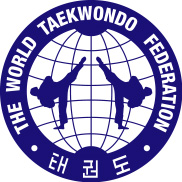 The World Taekwondo Federation is made up of Taekwondo national governing bodies (NGBs). The Korea Taekwondo Association (KTA) is the NGB for Taekwondo in the Republic of Korea. The United States Taekwondo Union (USTU) is the NGB for Taekwondo in the United States. Individuals may be affiliated with the WTF through their NGB, but individuals cannot join the WTF directly.
The World Taekwondo Federation is made up of Taekwondo national governing bodies (NGBs). The Korea Taekwondo Association (KTA) is the NGB for Taekwondo in the Republic of Korea. The United States Taekwondo Union (USTU) is the NGB for Taekwondo in the United States. Individuals may be affiliated with the WTF through their NGB, but individuals cannot join the WTF directly.
On January 8, 1977, nine of the largest kwans (Chung-Do-Kwan, Ji-Do-Kwan, Moo-Duk-Kwan, Chang-Moo-Kwan, Song-Moo-Kwan, Han-Moo-Kwan, Oh-Do-Kwan, Jung-Do-Kwan, and Kang-Duk-Won) recognized the Kukkiwon as the sole black belt promotional body for Taekwondo. Before this declaration, most practitioners valued their individual kwan certification more so than “official” certificates issued by the Kukkiwon or the KTA. By recognizing the Kukkiwon’s ultimate promotional authority in Korea, the kwan heads voluntarily gave up much of their power and prestige. Also in 1977, the WTF replaced kwan names with serial numbers. The kwan serial numbers are as follows: (1) Song-Moo-Kwan, (2) Han-Moo-Kwan, (3) Chang-Moo-Kwan, (4) Moo-Duk-Kwan, (5) O-Do-Kwan, (6) Kang-Du-Kwan, (7) Jung-Do-kwan, (8) Ji-Do-Kwan, and (9) Chung-Do-Kwan.
Taekwondo is now one of the national sports of Korea and is included in all school grades and as a requisite for military training. It has become so much a sport in Korea that the WTF now comes under the control of the Korean Athletics Association and not the martial arts body, the Ki-Do-Hae.
Since the formation of the WTF as a rival to the ITF, Taekwondo has not been a unified sport. Since the WTF headquarters is located in Korea, Korea has given its support the development of WTF Taekwondo. In the 1980’s struggle to determine who would govern Olympic Taekwondo, the WTF won.
Click here for more information
Recent
Historic Taekwondo Information
United States Taekwondo Union (USTU)
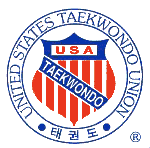 Now obsolete the USTU was founded in 1974 and was recognized as the ONLY official USA governing body of the World Taekwondo Federation (WTF) and the International Olympic Committee (IOC) up until 2005 when it was replaced by USA Taekwondo. www.usa-taekwondo.us/ (see the “UPDATE” at the bottom of the page)
Now obsolete the USTU was founded in 1974 and was recognized as the ONLY official USA governing body of the World Taekwondo Federation (WTF) and the International Olympic Committee (IOC) up until 2005 when it was replaced by USA Taekwondo. www.usa-taekwondo.us/ (see the “UPDATE” at the bottom of the page)
Delaware State Taekwondo Association (DTA)
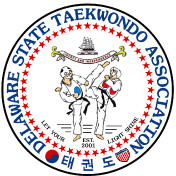 While the USTU was in operation our very own Grand Master Sung Hong Park established the DTA on February 11, 2001 and designed it’s official logo (as it appears to the left). The DTA was the USTU officially recognized governing body for the State of Delaware and was a proud achievement for Grand Master Park.
While the USTU was in operation our very own Grand Master Sung Hong Park established the DTA on February 11, 2001 and designed it’s official logo (as it appears to the left). The DTA was the USTU officially recognized governing body for the State of Delaware and was a proud achievement for Grand Master Park.
Olympic (or Sport) Taekwondo
In 1974, instructors in the United States, such as Ken Min, Dong Ja Yang, Mu Yong Lee, and others, worked for and attained the admission of Taekwondo into the Amateur Athletic Union (AAU). The newly established WTF technical standards were adopted by the AAU Taekwondo group.
On October 5, 1975, Taekwondo became an affiliate of the General Association of International Sports Federation (GAISF), an association of all international sports, both Olympic and non-Olympic, with direct ties to the International Olympic Committee (IOC). On April 9, 1976, the Conseil International du Sport Militaire (CISM) adopted Taekwondo as an official sport event.
In 1979, the WTF President, Kim-Un Yong, was elected chairperson of the World Federation of Non-Olympic Sports. Under the auspices of GAISF, Taekwondo was introduced to the IOC as a sport. On July 17, 1980, the WTF was granted recognition by the IOC at its 83rd General Session during the Moscow Olympics. On July 24, 1981, Taekwondo was one of the primary events in the World Games (non-Olympic events) held in Santa Clara, California.
On November 28, 1981, the United States AAU Taekwondo group changed its name to the National AAU Taekwondo Union of the Unites States. On February 5, 1982, Taekwondo was adopted as a demonstration sport for the 1988 Seoul Olympic Games at the IOC Executive Board Meeting. The crowning achievement of Taekwondo as a sport came at the General Session of the IOC held in Berlin in May 1982 when Taekwondo was designated an official demonstration sport for the 1988 Olympic Games in Seoul, Korea, and for the 25th Barcelona, Spain, Olympics, in 1992.
On September 9, 1984, the National AAU Taekwondo Union of the Unites States was renamed the United States Taekwondo Union (USTU) and was unanimously approved as a “Group A” member of the U.S. Olympic Committee. Today, the USTU is a non-profit amateur sports organization that is the national governing body for Taekwondo, as well as the sole representative of the WTF in the United States.
On July 3, 1986, the First World Cup Taekwondo Championship was held in Colorado Springs, Colorado. On September 30, 1986, the Tenth Asian Games Taekwondo Tournament was held in Seoul with 17 participating nations. On November 29, 1986, the First World University Taekwondo Championship was held. On August 9, 1987, Taekwondo was included in the Tenth Pan-American Games held in Indianapolis, Indiana. On October 7, 1987, the First Women’s World Taekwondo Championship was held in Barcelona, Spain.
On September 17-20, 1988, Taekwondo was a demonstration sport in the 24th Olympiad, with 192 players from 25 nations (male) and 16 nations (female). On August 14-17, 1991, Taekwondo was included in the 11th Pan-American Games held in Havana, Cuba. On August 3-5, 1992, Taekwondo was a demonstration sport in the 25th Olympiad, in Barcelona, Spain.
In 1986, Taekwondo was adopted as an official event by the All Africa Games and the by Federation International du Sport Universitaire. On September 4, 1994 in Paris, the 103rd Session of the IOC adopted Taekwondo as an official Olympic sport for the 27th Olympiad in 2000 in Sydney, Australia at the Sydney Exhibition Center, in Darling Harbor.
Taekwondo has consolidated its position in world sports faster than any other martial art sport. It is contested in the World and Women’s World Championships, World Cup Taekwondo, CISM Taekwondo Championships, and in the FISU World University Championships. It is now played as an official medal sport in most international multi-sport games such as World Games, Pan American Games, All Africa Games, Southeast Asian Games, and Central American Games. With the announcement that Taekwondo would be a full medal Olympic sport in the Sydney 2000 Olympics, Taekwondo gained worldwide recognition as a sport.
The now obsolete United States Taekwondo Union (USTU) “sport logo” appears below
followed by the new Official USA Taekwondo (USAT) logo.


Sport vs. Traditional Taekwondo
The International Taekwondo Federation (ITF) under the direction General Choi Hong Hi developed along different lines than the WTF. The ITF emphasized traditional Taekwondo while the WTF led in changing Taekwondo into a worldwide sport.
However, it is a misunderstanding to assume that the WTF does not incorporate traditional Taekwondo. They may emphasize sport collectively but many within the organization have practiced as well as begun a resurgence of the traditional aspects.
Before we explore further the relationship between traditions vs. sport Taekwondo we must first understand about Park’s Martial Arts (PMA) position and role in this issue.
Grand Master Park made a decision many years ago while still living in Korea to follow the recognized Taekwondo of his birth Nation, Korea. However, this does not mean that he ceased to practice traditional taekwondo. On the contrary, Park’s Martial Arts has always taught and continues to teach Traditional Taekwondo based on the synthesis of the WTF and Chang Moo Kwan approaches.
At PMA, sport Taekwondo is seen as an “option” for those who may find interest in pursuing such a venue. For these persons PMA H.Q. has a special competition team known as the Eagles which is designed to fulfill any competitive needs.
PMA recognizes that life is about diversity and freedom to choose according to how you, the individual, sees fit. Therefore, PMA recognizes the social “value” in both sport and tradition. Each has its place and each can be a stepping stone into a fulfilling way-of-life.
That said, let us now take a look at some of the differences between traditional and sport Taekwondo:
• The goals of traditional Taekwondo are self-development and spiritual improvement, while the goals of sport Taekwondo are demonstrating one’s superiority over an opponent-winning.
• Traditional Taekwondo reflects eastern values, while sport Taekwondo reflects western values.
• Traditional Taekwondo is process-oriented, while sport Taekwondo is result-oriented.
Sport Taekwondo stresses that the purpose of performing a technique properly is so you may score more points than your opponent in competition, and thus win. Therefore, it is possible to achieve this purpose during sparring. Sport Taekwondo gives value to the factors of power, accuracy, and strategy, and gives higher value to the use of more difficult techniques. It stresses that to execute a proper technique, you must have a resisting opponent. Because of the rules of sport sparring, it is possible to predict the actions of your opponent and to technically and psychologically manipulate and dominate your opponent.
Traditional Taekwondo stresses that the purpose of performing a technique properly is so it may be used to strike with enough force to disable or possibly kill an opponent-the philosophy of “one strike, one kill.” This is why traditionalists say they cannot use their techniques in contact competition, thus they cannot achieve this purpose during sparring. Instead, breaking is used to test the “lethality” of techniques.
Disagreements about what Taekwondo should become, led to a split between traditional Taekwondo (the martial art) and the new competitive Taekwondo (sport). Traditional Taekwondo is based almost entirely on Japanese principles, concepts, and techniques. Its four core training methods, patterns (poomse or hyung), breaking (kyukpa), sparring (kyorugi), and self-defense techniques (hoshinsul), are Japanese in origin. Sport Taekwondo did not develop the philosophies and concepts needed to supplant those that traditional Taekwondo adopted from karate, so it is still perceived as a subset of the original Taekwondo.
Click here for more information.
Other styles of “Taekwondo”
After the WTF concentrated more on the sport form of Taekwondo, Korean instructors began emphasizing competition techniques rather than traditional fighting techniques. For example, touch block replaced power blocks in sparring.
Korean based Taekwondo Groups
International Taekwondo Federation (ITF), Gen. Choi Hong Hi Global Taekwondo Federation (GTF), Park Jung Tae
American based Taekwondo Groups
As Taekwondo continued to grow in the United States, Taekwondo instructors wanted independence from foreign governing organizations. Instructors began grouping themselves and forming American based Taekwondo organizations. One of the first is the American Taekwondo Association (ATA). Others include, International Taekwondo Alliance (ITA), Taekwondo America (TA), American Korean Taekwondo Association (AKTA), United States Taekwondo Federation (USTF)
In Conclusion
Although the numerous Taekwondo organizations would seem to make choosing a Taekwondo dojang complicated, especially for prospective students, things are not as bad as they seem. Compared to most martial arts, Taekwondo is remarkably unified and well-structured. In roughly the same amount of time it took Taekkyon to become Taekwondo and split into two styles, Shaolin Kung-fu evolved into as many as 1,500 different styles. Students should research the different organizations and choose one that best fits their needs.
Taekwondo continues to grow and change.
Grand Master Park teaches us that it is important to choose quality martial arts. But it is equally important, if not more so, to choose a good martial arts Master.
UPDATE
As of 2005 the United States Taekwondo Union is no longer the Official Governing body of the World Taekwondo Federation. The new governing body is
U.S.A. Taekwondo
www.usa-taekwondo.us/
